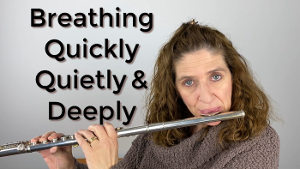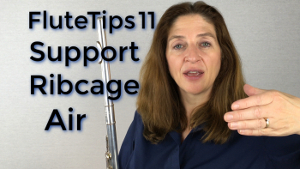Breathing in the middle of a solo can sometimes be quite tricky when done properly. Actually, I don’t think it’s that tricky, we just think it’s tricky and so we don’t do it properly. Generally, when we’re playing in the middle of a solo and we need to grab a breath, we do the gasp kind of breath because that’s what comes naturally. I do it. My students do it. I’m sure you do it. Unless we think about it, and plan for it, the result is less than desirable.
However, with planning, a quick, quiet and deep breath is not only achievable but mandatory.
Trevor Wye once said at a flute convention, after judging a competition, that Americans breathed too loudly. I don’t know if that is true, or if that statement actually applied to the whole world of flute. But whatever the real truth, I decided that I needed to analyze my own breathing… and I didn’t like what I heard! My breath was noisy. I was grabbing breaths with my throat tight, thus making an unseemly noise. Drat it all! Wye was right!
Breathing properly is something that we do spend time on. But breathing quickly in the middle of the solo is not. In the middle of a solo we just let it happen. You are playing along in a fast passage with multiple lines and you keep grabbing those little breaths when needed. The problem is, if you take a moment to listen to those fast quick breaths, these quick breaths make noise. There is a gasping sound, whether loud or soft, it’s still there.
The good news is that this can be fixed – and quite easily too. It just takes thought and practice.
I’m not going to get into how to breathe properly. I’ve done that before. You can look that up here. In review, keep in mind that when you fill up, you’re filling up your stomach and your rib cage. You’re expanding them both so that they are completely filled. When you inhale you create support by pressing against the ribs and tightening the muscles. In this way you control how fast that air is used.
Breath Deep
Now the thing to remember when breathing is that when you take a breath make it a deep breath. When you take a gasping breath in the middle of a piece, you are not taking a deep breath. A deep breath is quiet breath. All you need to do this is relax the muscles in the stomach and ribs and relax your throat. When we gasp for air, the throat tightens up. When it is loose, the intake of air can go low and fill up. All you really need to do is relax. Then since nature abhors a vacuum, the air will come in with very little help from you.
I would be hard pressed to say that this breathing took longer. I think the gasping breath and the deep breath are equal in length. That is, I can do the deep breath in the same amount of time, and perhaps just as easily as I can do the short gasps. If they are both the same in length why would we ever gasp again?
Breathing Quietly
Learning how to breath deeply applies to breathing quietly too. Generally, the reason why your breath is not quiet is because the throat is tight. Let’s get a little more specific with the tight throat. When it is tight, the back of the tongue is too high, the the soft palate on the roof of the mouth is down. We want to act like a singer. When a singer takes a breath everything is open. The singer lowers the back of their tongue, and raises the soft palate. That way the sound can resonate in the sinus cavity.
The best way to think about that is to take a yawning breath. What I mean by that is when you yawn everything opens up and generally it opens up all the way to your sinus cavity. It creates a straight line all the way up to the sinuses. This is your aim. When you get ready to breath relax the throat and open it as pipe or tunnel. Think about it as being big enough that an orange could fit. This opening up to the sinuses has an added benefit of giving you a better more resonant tone.
Breathing Quickly
I’ve mostly established this already. When you breath deeply filling up all the way and relaxing the throat to breathe quietly, you also breathe quickly. It all works together. If one of these components doesn’t work then pretty much none of them do.
It’s not always easy disciplining yourself to take yawning breath in the middle of the piece. It takes practicing this method of breathing. It takes discipline to do it every time. This is the tricky part. It’s not the act in and of itself that is hard. It is the practice of doing it every time no matter how fast you are playing.
If I don’t actually take the time to learn how to do it in practice, I won’t do it in performance. It’s something that you train yourself to do. Train yourself to take that quiet breath and not have to have some recording device or editing to take that breath out. It’s very important and it’s doable. You can do it.
So, practice breathing deeply expanding your rib cage and your stomach when you breath by relaxing those muscles. Relaxing those muscles, allows the air to come in and it wants to come in, and you only have to add a little bit of effort to fill it up. Next open your throat, which means take a yawning breath. When you relax the stomach, the rib cage and the throat all together, it becomes a quick breath and you can do it very quickly and very quietly.
Practice this. It takes a little bit of practice to, to figure it out so you can do it in any solo at any time, no matter how quickly or how slowly you’re playing. But it does take work. It takes training, especially if you’re not used to doing it because when you are nervous, you will resort back to your old habits. You have to train new paths in your brain to do your breathing this way, that that is your only option.
Try it. You’re going to find out that it really will work for you. You’ll have a lot of success. Not only does your breathing become quieter, which everybody likes, because who likes to have the gasping sound in the middle of a performance? But by opening up, taking that yawning breath, you’re going to have resonance that you didn’t have before.
Try it. You’re going to like it. It will work for you!
Have fun!
DoctorFlute
Watch my video of this: FluteTips 97 Breathing Quickly Quietly & Deeply

FluteTips 11 Support – Ribcage Air

FluteTips 56 Improve Your Tone by Opening Your Throat


FluteTips 26 Open Sinuses for a Better Tone

